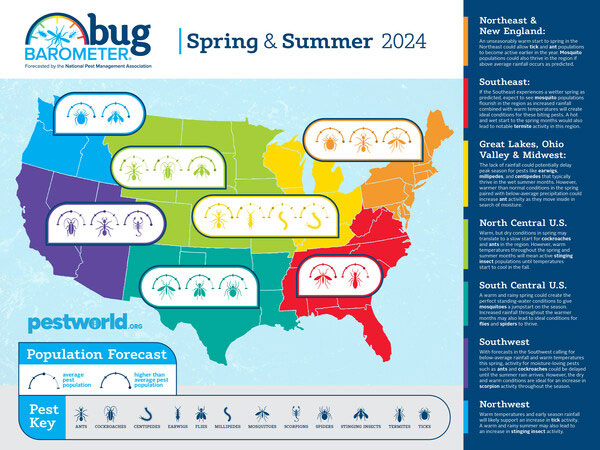
IMAGE: NPMA
The National Pest Management Association (NPMA) released its bi-annual Bug Barometer, forecasting what Americans can expect from pest populations in their respective regions across the U.S. this spring and summer based on weather patterns, long-term forecasts and pest biology.
Due to erratic weather patterns throughout the winter and a warm spring expected across the U.S., NPMA’s expert entomologists are warning of increased populations of pests including ticks, mosquitoes, ants and more.
“The U.S. has experienced some wild weather this year. We’ve seen everything from heavy snowfall to extreme flooding and even unseasonable warmth in some areas,” said Dr. Jim Fredericks, senior vice president of public affairs at the NPMA and a Pest Management Professional magazine contributor. “While we typically anticipate an increase in pest activity during the spring and summer, these conditions, paired with warm temperatures and rainfall on the horizon, can create the ideal conditions for pest populations to boom.”
Based on their analysis, the NPMA’s Spring and Summer 2024 Bug Barometer is forecasting an uptick in pest pressure across the U.S.:
Northeast and New England
An unseasonably warm start to spring in the Northeast could allow tick and ant populations to become active earlier in the year. Mosquito populations could also thrive in the region if above average rainfall occurs as predicted.
Southeast
If the Southeast experiences a wetter spring as predicted, expect to see mosquito populations flourish in the region as increased rainfall combined with warm temperatures will create ideal conditions for these biting pests. A hot and wet start to the spring months would also lead to notable termite activity in this region.
Great Lakes, Ohio Valley and Midwest
The lack of rainfall could potentially delay peak season for pests like earwigs, millipedes and centipedes that typically thrive in the wet summer months. However, warmer than normal conditions in the spring paired with below-average precipitation could increase ant activity as they move inside in search of moisture.
North Central
Warm, but dry conditions in spring may translate to a slow start for cockroaches and ants in the region. However, warm temperatures throughout the spring and summer months will mean active stinging insect populations until temperatures start to cool in the fall.
South Central
A warm and rainy spring could create the perfect standing-water conditions to give mosquitoes a jumpstart on the season. Increased rainfall throughout the warmer months may also lead to ideal conditions for flies and spiders to thrive.
Southwest
With forecasts in the Southwest calling for below-average rainfall and warm temperatures this spring, activity for moisture-loving pests such as ants and cockroaches could be delayed until the summer rain arrives. However, the dry and warm conditions are ideal for an increase in scorpion activity throughout the season.
Northwest
Warm temperatures and early season rainfall will likely support an increase in tick activity. A warm and rainy summer may also lead to an increase in stinging insect activity.
Leave A Comment